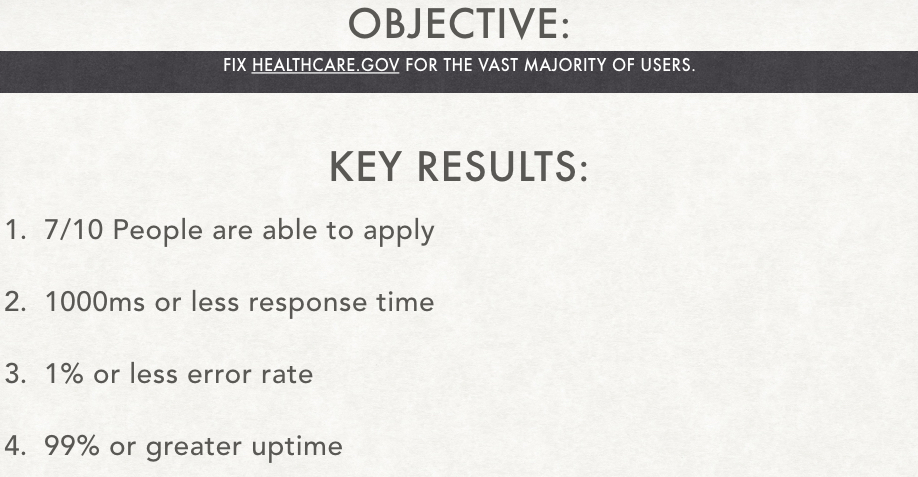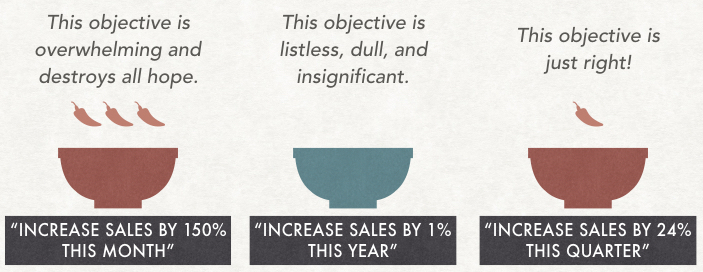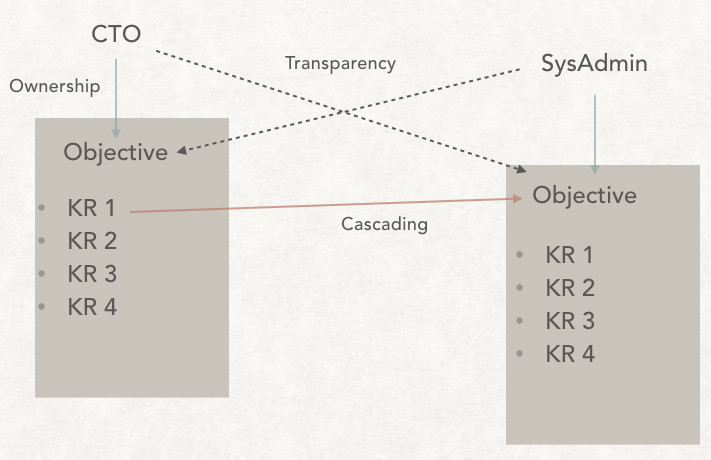Set & Achieve Your Goals Using OKRs

If you lack a systemized process for setting and achieving goals, your likely to run into all sorts of problems:
- Writing vague goals.
- We pick the wrong goals.
- Tackling too many goals.
- Choosing goals that are too hard.
- Choosing goals that are too easy.
- Defining conflicting goals.
- Create goals without committing to our goals.
- We don’t hold ourselves accountable.
Plenty of people will tell you the importance of setting goals. What people don’t tell you is how to choose, set and accomplish them.
In Measure What Matters, John Doerr lays out an approach to goals to tackle these challenges. John taught this to industry juggernauts Google, Intel, Adobe, and Intuit and others. Its design increases focus, commitment, and ambition. Among teams, It fosters alignment, transparency, and accountability.
Introducing OKRs
The system is OKRs, short for Objectives and Key Results. An Objective is something that you intend to accomplish, your goal: Your what. An objective contains several key results, which are objective, quantifiable measures of progress: Your how.
Here’s an example OKR From their website:

Defining Your Objectives And Key Results
the system works like this:
- Decide on 3 – 5 objectives you would like to achieve and define them.
- For each of those 3 -5 objectives, you choose 3 – 5 key results you can use to track progress toward achieving that objective.
- From there, you decide how to do the best work that fits into this framework.
Before deciding your objective, you have to decide where it is you want to go. If objectives are what you are doing, and key objectives are how you are doing it, then where you are going is your mission.
For example, Google’s mission is to “Organize all the world’s information.” Your personal mission may be raising your children or gaining financial independence. Your company may have one of these plastered on a wall or ‘about’ page.
Choosing objectives you can commit to takes deep thinking. Don’t try to define objectives no Monday and begin working towards them on Tuesday. Give your self some time to consider exactly what it is you want to accomplish.
When you’re ready to move forward, lets take a closer look at how to define quality objectives and key results.
Characteristics of Strong Objectives
Objectives need to be clear and understandable. In the Healthcare.gov example you’ll see that while the objective sounds initially vague, the key results give it precision. You can set up systems to measure each of these and determine objectively how well you achieved your goal. Another benefit of clarity is that it increases alignment within a team. There’s no debate about what we are all working together to accomplish.
Achieving every key result achieves the objective. If that isn’t true then you need to tweak your OKR. One trick recommended in the book is to try to rewrite your objectives and key results ending with “as measured by ________”. In this case, your objective is measured by the sum of all key results.
Objectives must be worth achieving. What’s the point of pursuing a goal that isn’t going to have a significant impact on your business or life?
You should timebox objectives. The time frame could be monthly or quarterly, but its recommended to not think in longer time frames. Longer time frames mean aiming for more ill-defined objectives. Shorter time frames may be ok at the start, as a warm-up, but it is hard to accomplish significant work in a weekly time frame.
Write down your objectives. If you don’t, then they cannot be clearly discussed and people cannot be held accountable.
Defining Clear Key Results
Key results must be measurable. As a general rule, they should be a number. “Deliver prototype by 10/31” is a number. On that date, the number of delivered prototypes will be zero or one.
These numbers should also be objective. Getting approval from a manager is not a good key result is all it relies on is one person’s discretion. If you want to set results for measures of quality such as user experience, find ways to quantifiably measure that, through either analytics or surveys.
Key results should include measures of quality. All metrics are games, and key results should be defined to prevent harmful gaming. For example, “publish 100 blog posts this quarter” is a dangerous metric, because it contains no bounds what a “blog post” is. A team ignoring quality could hit this target in weeks if not days. You could improve this KR by also defining a metric around the impact of the posts, such as conversion rates, engagement, etc.
The Goldilocks Ambition Zone

Here’s where I think the system goes from solid to genius: When it comes to setting your goals, you should aim for a success rate of 70%. Aiming for a 100% goal rate gives you an incentive to set less ambitious goals. Have a hit rate too low means you are setting goals that are unachievable. 70% is a good middle ground: You succeed more than fail, but you are still stretching and being ambitious.
Imagine how different education would be if you were encouraged instead of punished for tackling challenges outside your comfort zone.
As a gut check, take stock of how you feel when you look at the OKRs you are responsible for achieving. How do you feel? Do you feel very confident that you pull them all off? Then you didn’t stretch enough. Can you shorten deadlines or increase targets?
What if you feel scared like there is no way you’ll even come close? That may be a sign that you are reaching too much. Setting goals that are unreachable are defeating. If you know you won’t come close, why should you try? What will motivate your team?
But, if you look at your targets, and you feel like maybe you could achieve these, or at least most of these, if you push yourself, then you’ve found the Goldilocks zone. You have objectives that will test you, but with a test that you can pass if you get outside your comfort zone.
As my coach likes to say: “Get comfortable being uncomfortable.”
Measuring Success
While objectives completion is always a clear yes or no, measuring progress and achievement can be more nuanced. Let’s say in our previous example of writing 100 blog posts in a quarter. You could write 70. While you did not achieve the goal, you did achieve 70% of it. Think about measuring each of your key results on a 0.0 – 1.0 scale, with the following goal posts:
- 0.0 – 0.3: Red: You failed or have not made significant progress.
- 0.3 – 0.7: Yellow: You have made some progress, but still fell short.
- 0.8 – 1.0 : Green: You have achieved all or most of the goal.
These numbers should be from both objective metrics and self-evaluation. Consider the 99% uptime key result from the earlier example. If your site has 70% uptime, would you say that’s yellow or red? In that scenario, a more reasonable scale would be something like < 95% uptime is red, 95-98% is yellow, and 98-99% is in the green range.
You may also consider separating objectives into “stretch” and “committed” categories. Some goals may be important to hit and you should really be thinking about going for 100% there. Others may be more ambitious but also less costly if they fail, so aiming higher there is ok.
Tracking Progress
Instead of annual or quarterly performance reviews, the OKR system encourages continuous feedback with another acronym: CFRs. CFRs stand for Conversation, Feedback, and Recognition. Conversations should focus on facts over feelings, and process over outcome. These are not a replacement for annual or quarterly performance reviews, which are used to determine other measures, mainly compensation based on performance. It’s important that you divorce feedback on goals from compensation. Changing compensation is backward facing and about the person, while CFR discussions are forward facing and about the goal. Both are more effective when decoupled. Here are 5 questions from Measure What Matters that can help frame these discussions:
- What are you working on?
- How are your OKRs coming along?
- Is there anything impeding your work?
- What do you need from me to be more successful?
- How do you need to grow in order to achieve your goals?
As teams work together, it’s important to remember to recognize when others do well in a public and visible manner. It helps people remember how their work helps others.
OKRs In Teams: Transparent, Interconnected Cascades
OKRs are primarily designed for teams, although I think they are valuable for individuals also. When working in teams, how multiple OKRs interact with one another is another powerful part of the system.
OKRs cannot be written and handed down from up high. You must write them collaboratively. However, One manager’s Key Result and be someone else’s objective. For example, let’s look at the Healthcare.gov example again. Let’s imagine that this OKR is from the CTO who is responsible for the project. One of the key results is 99% uptime. This could be an objective for the person or team who is in charge of systems administration, who could then define sub-KRs that could them achieve that objective. You can break the KR “Response time of under 1 second” into other objectives and key results for front end and back end development teams. While OKRs are not assigned top-down, they do cascade down or sideways. This helps people contributing at any level to see how their work connects to the bigger picture.
A single person should own objectives. If that’s not possible then they should be owned by a single team. Focus is important, so no single person or team should have more than five objectives. Another benefit is the focus that this brings. If work does not go towards or at least facilitate the pursuit of a key result, then you can confidently remove it from the backlog of tasks.
The interconnectedness leads to another feature of OKRs in teams: They must be transparent. Everyone can see everyone else’s OKRs along with progress. It helps keep people honest. It also helps avoid situations where teams are blind to others work. One team might be able to help another if they knew the challenges another team was facing. Or it is possible that teams have conflicting goals and are working against each other without knowing it. Transparency breeds accountability and alignment. This also helps encourage clarity in objectives. If everyone in the company can’t understand it, it may need some tweaking.
With these systems, you need to encourage a culture that supports safety. By that I mean if you are encouraging people to stretch for goals where they will fail 30% of the time, then people need to feel comfortable talking about mistakes and failures. transparency is easier when you know you will not be mocked or admonished for taking risks that might not pan out. On the flip side, you should also aim for a culture that encourages doing quality work and being a place where you can count on others to do so as well.

According to a study by Deloitte, the largest increase in job satisfaction and productivity comes with a company has clearly defined goals, written down, and shared freely.
Implementing OKRs
I think OKRs are useful not only in a team setting but individually as well. After reading Measure What Matters I’ve begun applying the system to personal goals like finance. OKRs are a big shift that will not overhaul a company or a human overnight. Start small. Maybe you can set 1 – 2 OKRs on your own, or with your team. Try one for a weak or a month and see how it feels. If you are seeing positive results and getting your footing in systemized goal setting, you can begin to expand how often you use them.
I also would not recommend jumping in too quickly. Don’t try to define OKRs and commit and implement them on the same day. Take some time to reflect on what you are doing and how you’ve defined it. Another thing to remember is that OKRs can be flexible. Don’t give up on an OKR because its hard, but feel free to adjust definitions and key results if you find better ways to measure them. If you realize that an OKR no longer seems to have meaning or impact, kill it. If you finish your 3-month OKR in two, consider starting another one early.
By implementing these systems, you can overcome most of the common reasons people don’t achieve their goals. Let’s look at the list from before, and how you could approach setting goals differently now:
- Your goals are vague, they are specific, measurable, and actionable.
- You’ve considered how your goals fit into a larger mission.
- By targeting 70% success, you’ve ensured that won’t set goals that are too hard or too easy.
- By being clear and transparent, you’ve ensured that goals increase, rather than decrease alignment.
- That clarity also means you have the incentive to hold yourself and others accountable.
- You’ve put a system of feedback and continuous improvement in place, making it easier to commit to and achieve your goals.
It’s not magic, but it’s also not easy. OKRs won’t magically make you a 10x productivity wizard or fix a toxic company culture, but it can give you a framework and a process from which you can make improvements.